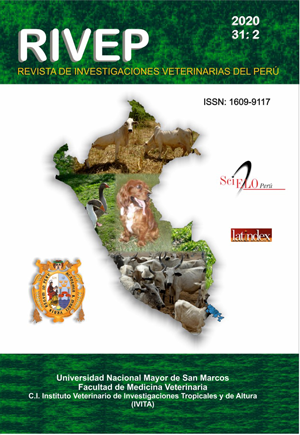Corpses of cats chemically prepared for the teaching of surgical techniques
Biomechanical analysis of skin and jejunum
DOI:
https://doi.org/10.15381/rivep.v31i2.16172Keywords:
anatomy, felines, conservation, traction, techniqueAbstract
The aim of this study was to evaluate the feasibility of using ethanol (AE) and an aqueous sodium chloride solution 30% (ASCS) in various time periods for the preparation of carcasses of cats for the teaching of surgical techniques. The corpses of 60 cats were used. The specimens were fixed in AE, according to group, for 30 days (G1), 30 and 60 days (G2) and 30, 60 and 90 days (G3), and ASCS was applied to all of them at 30, 60, 90 and 120 days of conservation and the result was measured by means of the biomechanical study in the tissues to determine the best moment to interrupt the fixation in AE using as control the greatest similarity in tissue resistance found in fresh cadavers. The use of the anatomical technique using AE and ASCS was efficient throughout the experiment. There was no significant difference between the mean value of the maximum breaking force (N) or between the storage groups in the ASCS and the control group in any of the groups for the skin samples. Neither was there a significant difference in maximum force between fixation and preservation groups, compared to the control group in the groups for jejunum samples. However, G2 presented less variation in the breaking force (-0.21 mm), being, therefore, the group most similar to fresh animals. The anatomical technique used was found to be efficient for both fixation and preservation of cat carcasses for up to seven months.
Downloads
Downloads
Published
Issue
Section
License
Copyright (c) 2020 Raphael Chiarelo Zero, Antonio Carlos Shimano, Marita Vedovelli Cardozo, Caio César Carmo Santos, Alisson Diego Senna Fechis, Thiago André Salvitti de Sá Rocha, Fabricio Singaretti de Oliveira

This work is licensed under a Creative Commons Attribution-NonCommercial-ShareAlike 4.0 International License.
AUTHORS RETAIN THEIR RIGHTS:
a. Authors retain their trade mark rights and patent, and also on any process or procedure described in the article.
b. Authors retain their right to share, copy, distribute, perform and publicly communicate their article (eg, to place their article in an institutional repository or publish it in a book), with an acknowledgment of its initial publication in the Revista de Investigaciones Veterinarias del Perú (RIVEP).
c. Authors retain theirs right to make a subsequent publication of their work, to use the article or any part thereof (eg a compilation of his papers, lecture notes, thesis, or a book), always indicating the source of publication (the originator of the work, journal, volume, number and date).










